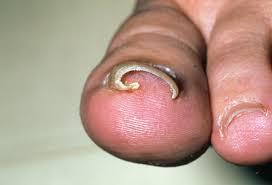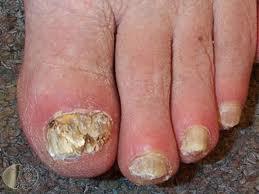Nail Fungus & Nail Health
Our nails serve many important roles. They protect and support the tissues in our fingers and toes. Having nails allows us to scratch an itch. A look at your nails can warn a doctor of an underlying medical condition, such as heart disease or diabetes.
The Long And Short Of Nails
Our nails serve many important roles. They protect and support the tissues in our fingers and toes. Having nails allows us to scratch an itch. A look at your nails can warn a doctor of an underlying medical condition, such as heart disease or diabetes.
Nail Basics
Nails are essentially hardened skin cells. Made mostly of keratin, a protein found in the skin and hair, nails are made by living cells in the fingers and toes. These living cells begin in the matrix, the hidden (half moon) area under the cuticle. As new skin cells grow in the matrix, the older cells are pushed forward, harden, and form a visible nail.Nail Growth
How quickly a person’s nails grow depends on several factors. Nails grow faster in summer than winter. Men’s nails grow more quickly than women’s, except possibly during pregnancy and old age. The nails on a person’s dominant hand (hand most used) grow faster. The growth rate of fingernails outpaces toenails. On average, fingernails grow 2 to 3 millimeters in one month, and toenails grow 1 millimeter per month. Disease, hormone imbalance, and aging can slow nail growth.
Common Nail Disorders
While uncommon in children, nail disorders affect a large number of older adults. As we age, nails thicken and become more susceptible to fungal nail infections. Circulatory problems and use of medications, which also tend to increase as we age, raise the risk of developing a nail condition. The following describes common nail conditions and the causes:White Spots
Most often caused by mild trauma, such as catching one’s finger in a door, these small spots appear when the base (matrix) of the nail is injured. Such white spots are very common, eventually grow out, and are no cause for concern. If you suddenly see a number of white spots and do not remember injuring your nail or the white spots do not seem to grow out, be sure to make an appointment to see a dermatologist. White spots also can indicate an infection or other medical condition.
Splinter Hemorrhages
Appearing as a red to reddish-brown fine, vertical line that resembles a splinter beneath the nail, this disorder occurs when blood vessels in the nail bed are damaged. The most common cause is nail injury. Certain medications and medical conditions also can cause a splinter hemorrhage, so these should be examined by a dermatologist.
Ingrown toe nail
This common nail disorder occurs when the side of the nail grows into the skin. The big toenails are particularly vulnerable. Improper nail trimming, tight shoes, or uneven pressure distribution while walking can lead to this common nail problem. Ingrown nails may be painful and sometimes lead to infection. Sometimes surgical removal of nail may be required.


Fungal Infections (Onychomycosis)
Fungus is the most cause of nail infections.. More frequent on the toenails than on the fingernails
The two most common types of fungi affecting the skin are dermatophytes and yeast (Candida). While both types infect nails, dermatophytes tend to be more common in toenails. Yeast infections are seen more frequently in fingernails. While some fungal nail infections may respond to topical antifungal creams, lotions, gels, and lacquers, most infections of the nail plate require oral medicines such as itraconazole, terbinafine, and fluconazole. Housewives and diabetics are more prone to have fungal inection of nails.
Bacterial Infections
Redness, swelling, and pain of the skin folds around the nails often indicate an infection caused by bacteria. The most common cause of a bacterial infection is injury to the nail or surrounding skin. Frequent exposure to water and chemicals is a common cause of these bacterial infections. Sometimes a green discoloration of the nail occurs. A bacterium called pseudomonas causes this discoloration.
Tumors And Warts
These may be found in any portion of the nail and can cause the nail plate to change shape. When a growing tumor or wart interferes with nail growth, it can destroy the nail. Warts are viral infections that affect the skin surrounding or underneath the nail. They can be painful and sometimes limit use of the affected finger or toe. Treatment usually involves destroying the wart with freezing or chemicals. If a wart or tumor extends into the nail folds or is located under the nail plate, surgery may be necessary to remove it. .
Dark Spots Or Streaks
If a dark spot or streak appears on any nail, and is not the result of an injury, it must be examined by a dermatologist. This could be melanoma, the most lethal form of skin cancer.
Psoriatic Nails
Psoriasis is a chronic skin condition that causes red, scaly patches. Approximately 10% to 50% of people with psoriasis, and 80% of people who suffer from psoriatic arthritis have nail problems, especially with their fingernails. The most common signs include pitting, rippling, and discoloration of the nail. With psoriatic nails, it is common for the skin beneath the nail to develop a reddish-brown discoloration. Splinter hemorrhages can form. The nail may separate from the nail bed, crumble, and/or split. Swelling and redness of the skin surrounding the base of the nail also are common.
Nail Biting ( Onychophagia):
Not only does nail biting ruin the look of the nails, it can damage the skin surrounding the fingers, allowing infections to enter and spread. Nail biting also is an easy way to transfer infectious organisms from the fingers to the mouth and vice versa. To prevent nail biting nail polishes containing Denatonium benzoate can be applied to the nail . It tastes very bitter and hence stops the patient from biting the nails further .If nail biting is constant and severe, it may be a sign of anxiety.Treating Nail Disorders
While most minor nail injuries heal without treatment, severe nail disorders require medical care. The following nail problems should be reported to a dermatologist:
- Change in the color or shape of a nail
- Swollen skin or pain around a nail
- White or black line visible in a nail
- Dents or ridges in a nail
If treatment is prescribed, it is important to know that therapy can be a challenge. Nails grow slowly, so they respond slowly to treatment. Due to their thickness, nails do not absorb topical medications very well. Oral medication is often necessary. Surgical treatment is common to remove tumors and correct structural abnormalities.
Mirror on health
The nails can reveal much about a person's overall health. Many diseases and serious conditions can be detected by changes in the nails. This is why doctors often check the nails carefully during a physical examination. The most common health conditions that the nails may be revealing are:
Treating Nail Disorders
While most minor nail injuries heal without treatment, severe nail disorders require medical care. The following nail problems should be reported to a dermatologist:
| Condition | Nail Appearance |
|---|---|
| Liver Diseases | White nails |
| Kidney Diseases | Half of nail is pink , half is white |
| Heart Conditions | Nail bed is red |
| Lung Diseases | Yellowing and thickening of the nail, slowed growth rate |
| Anemia | Pale nail beds |
| Diabetes blush | Yellowish nails, with a slight at the base |
Nail Care Tips
Many nail disorders result from poor nail care, so developing good nail habits can help. To keep your nails healthy, dermatologists recommend:
- Keep nails clean and dry. This helps prevent bacteria and other infectious organisms from collecting under the nail.
- Cut nails straight across, rounding them slightly at the tips for maximum strength. Be sure to use sharp nail scissors or clippers. Filing the nails into points weakens them.
- Keep nails shaped and free of snags by filing with a "fine" textured file.
- Avoid biting fingernails, and do not remove the cuticle.
- Trim toenails regularly to keep them short. This minimizes trauma and injury.
- Soak feet in warm salt water (one teaspoon of salt per pint of water) for five to 10 minutes when toenails are thick and difficult to cut, then apply urea or lactic acid cream. This softens the nails, making them easier to trim.
- Avoid "digging-out" ingrown toenails, especially if they are already infected and sore. See a dermatologist for treatment.
- Wear shoes that fit properly and alternate pairs.
- Report any nail irregularities to your dermatologist. Nail changes, swelling, and pain could signal a serious problem.
- Be especially vigilant of nail problems if you have diabetes or poor circulation. At the first sign of a problem, see a dermatologist.


